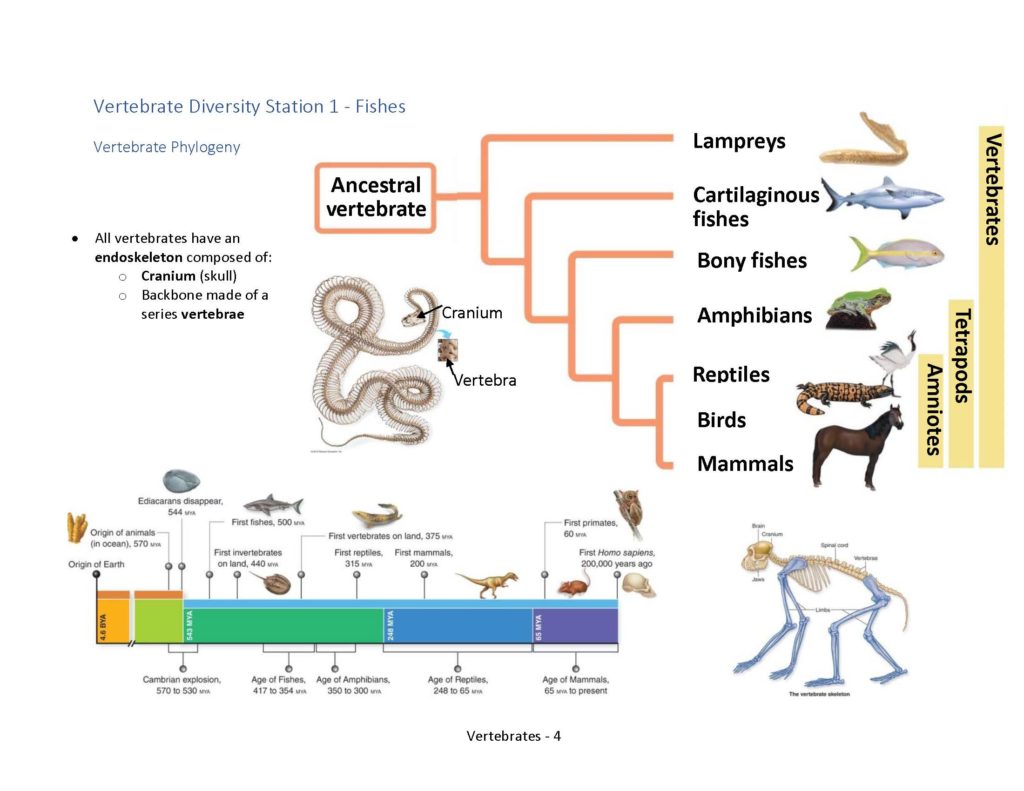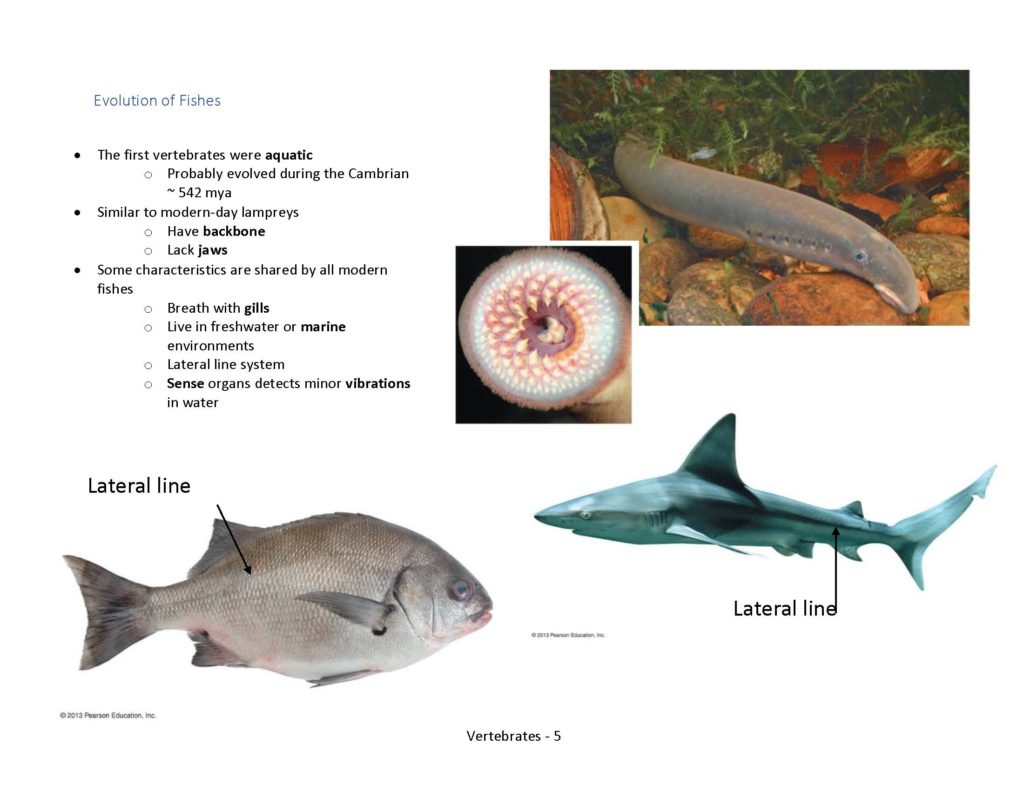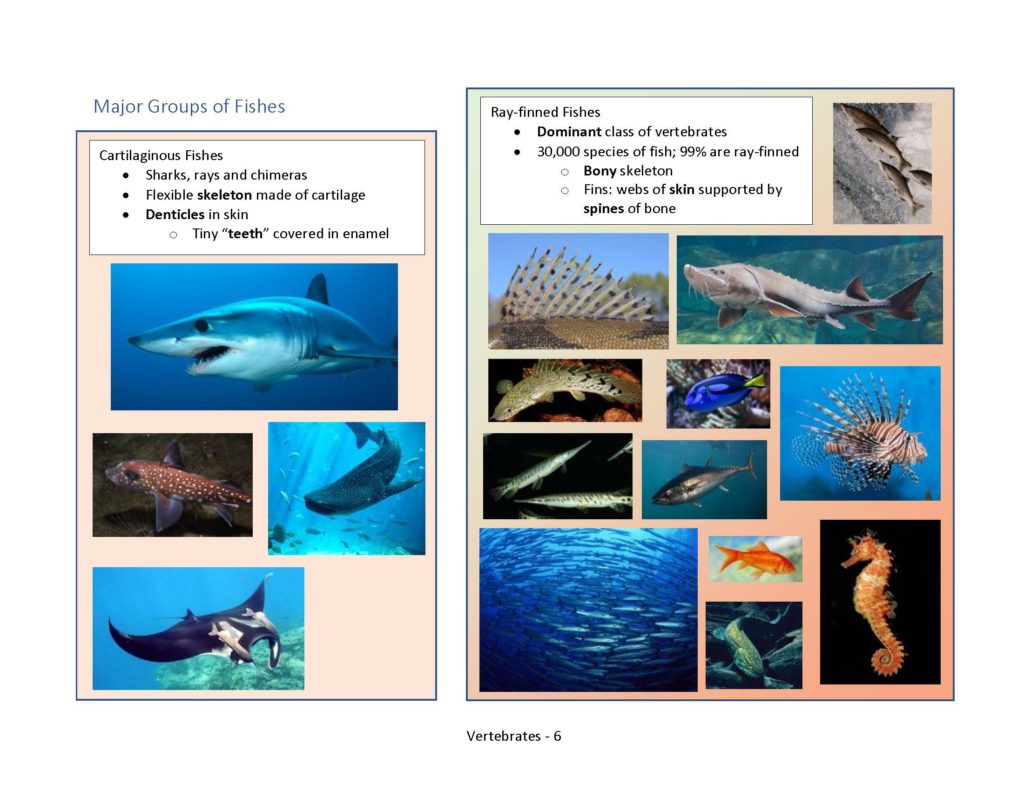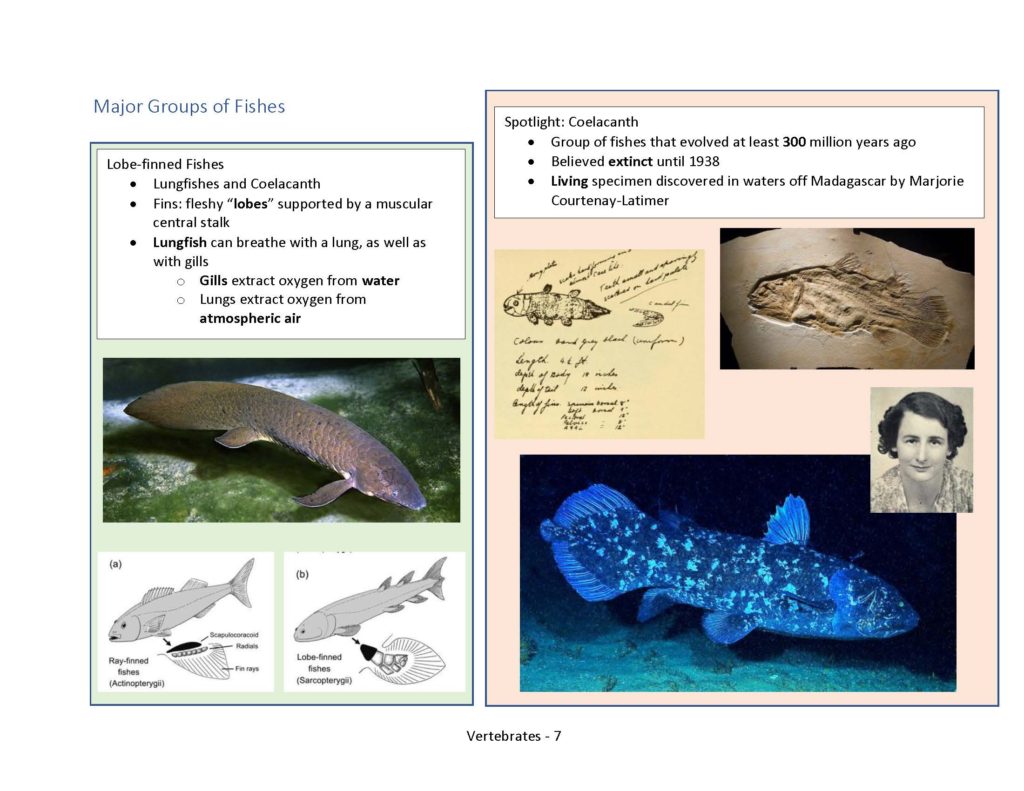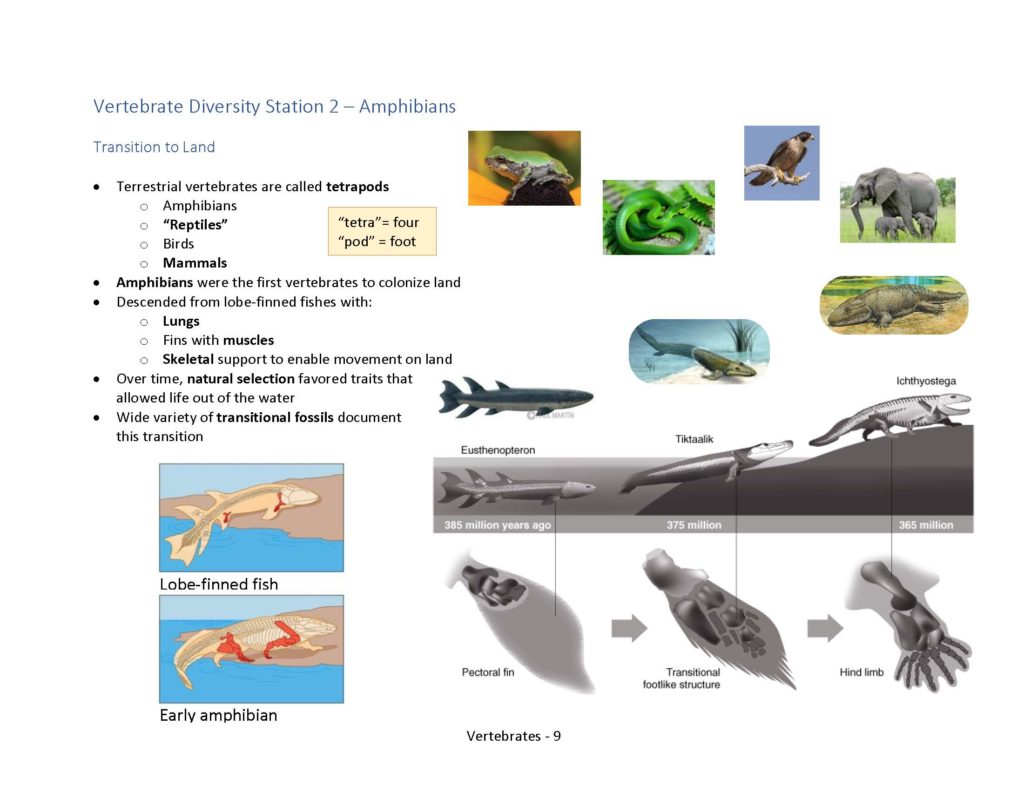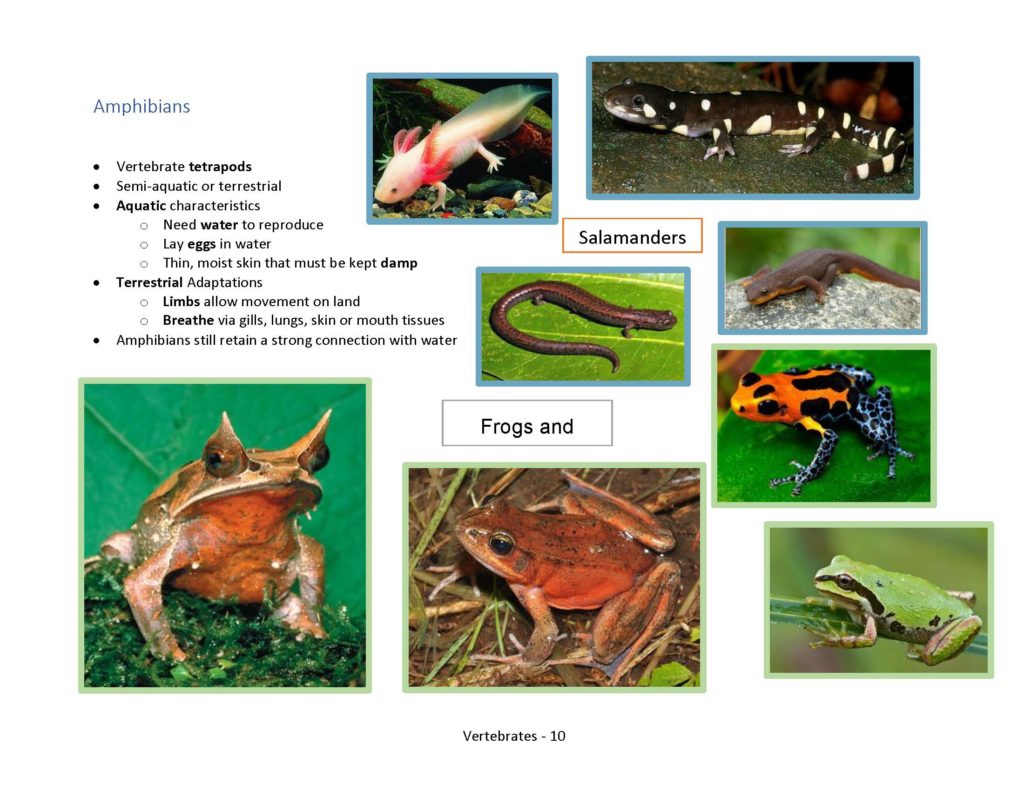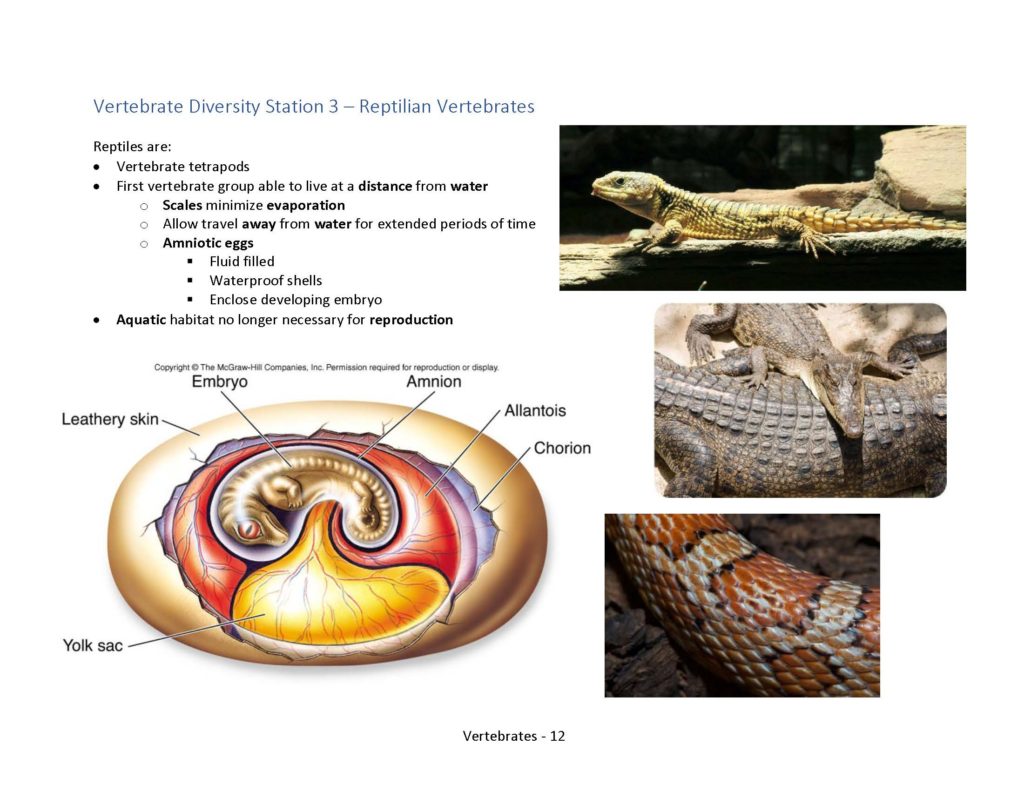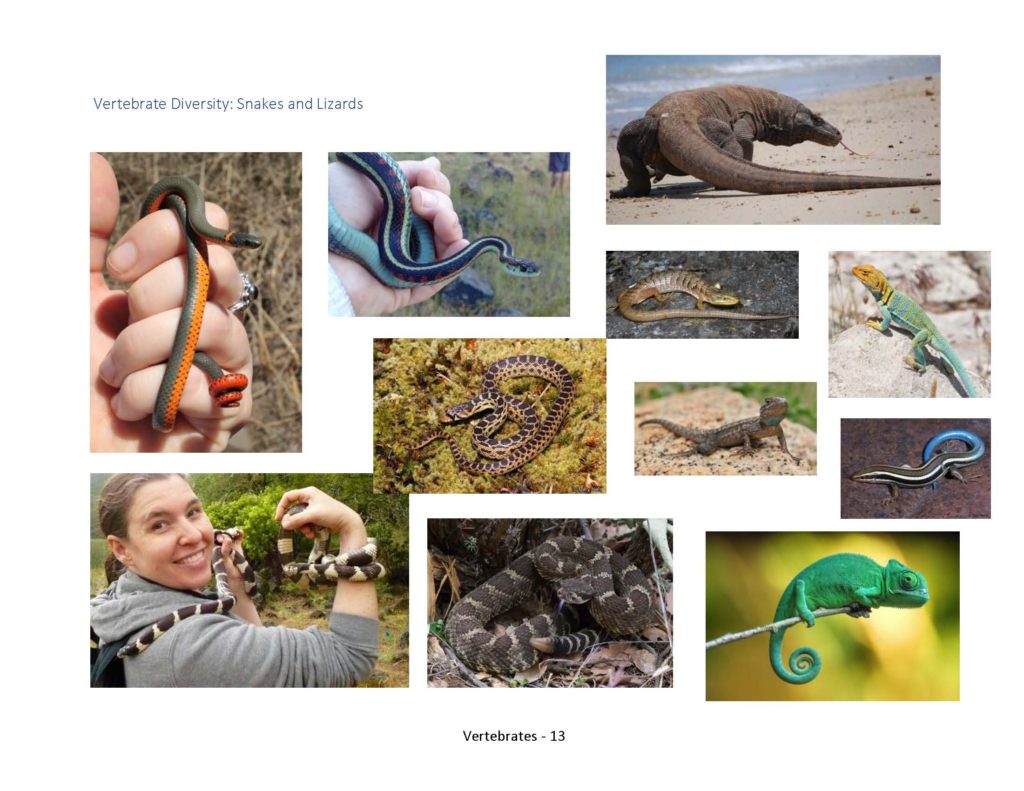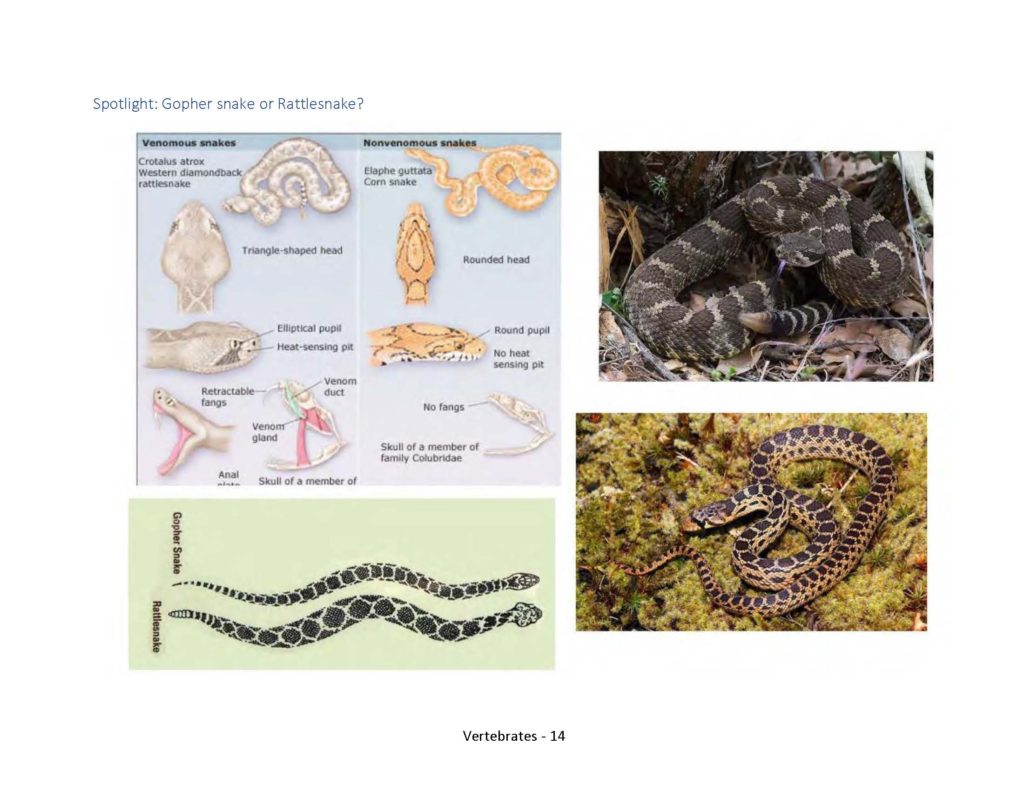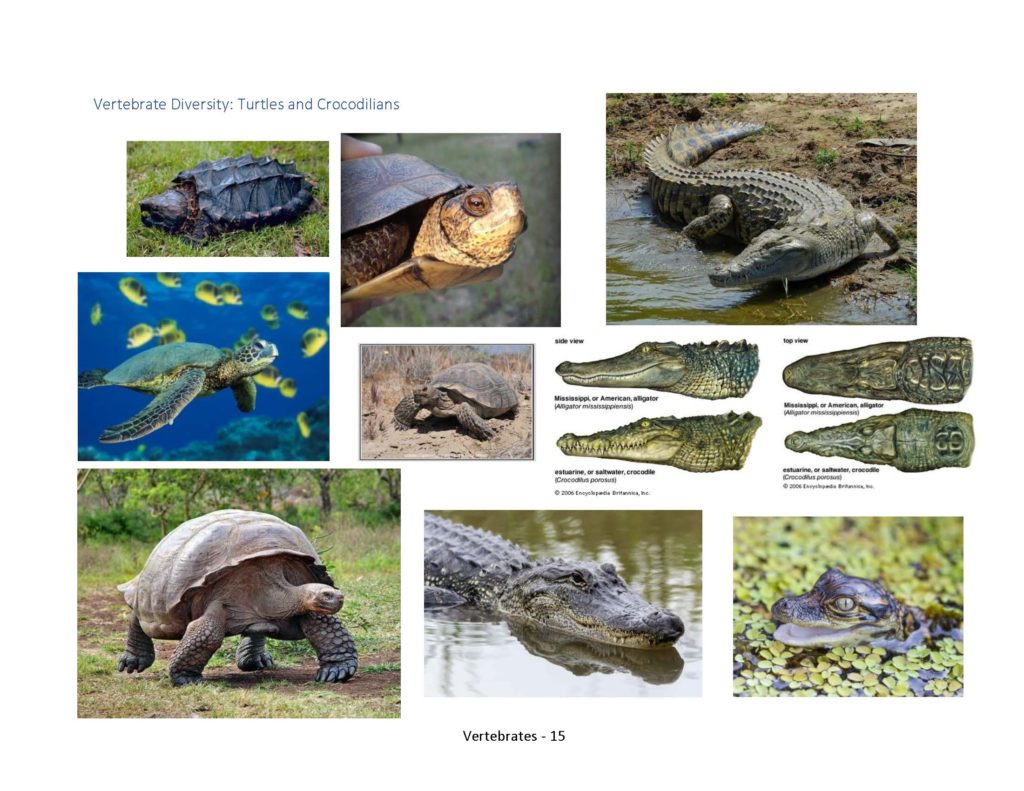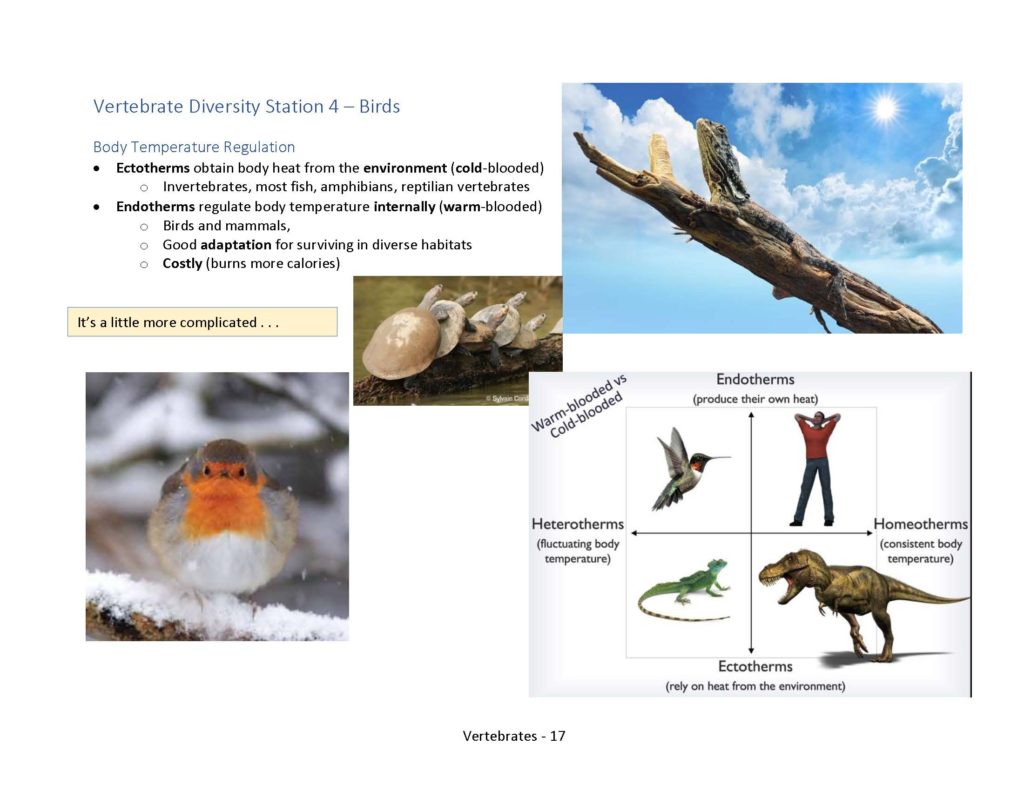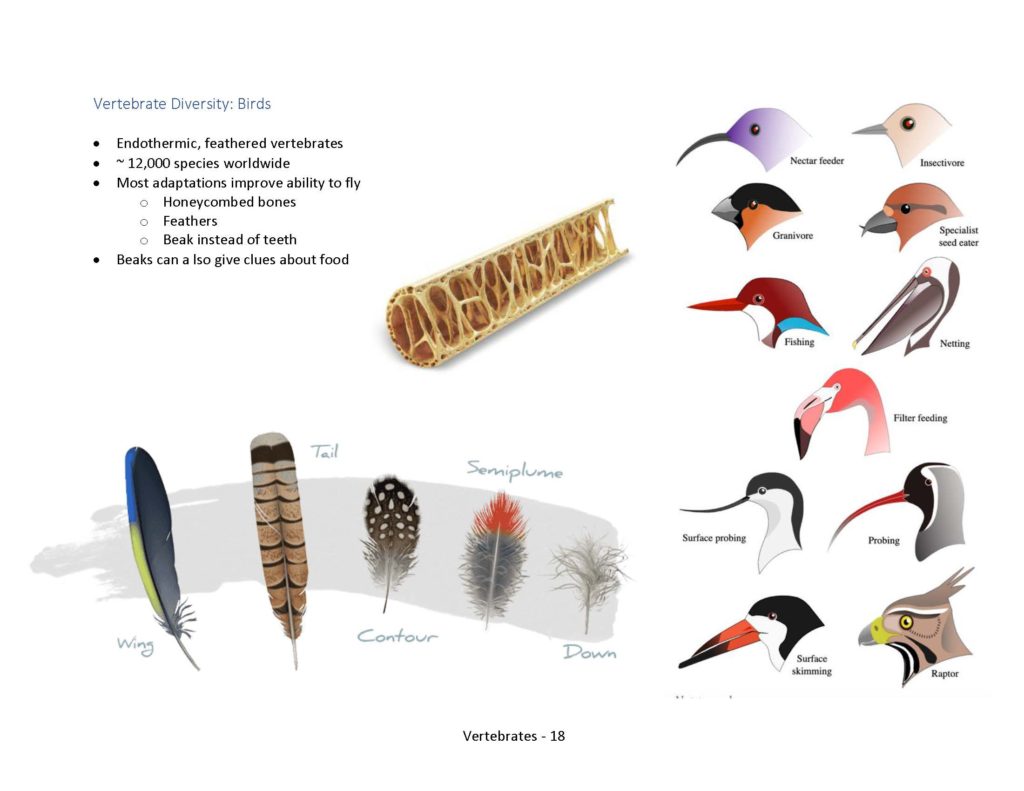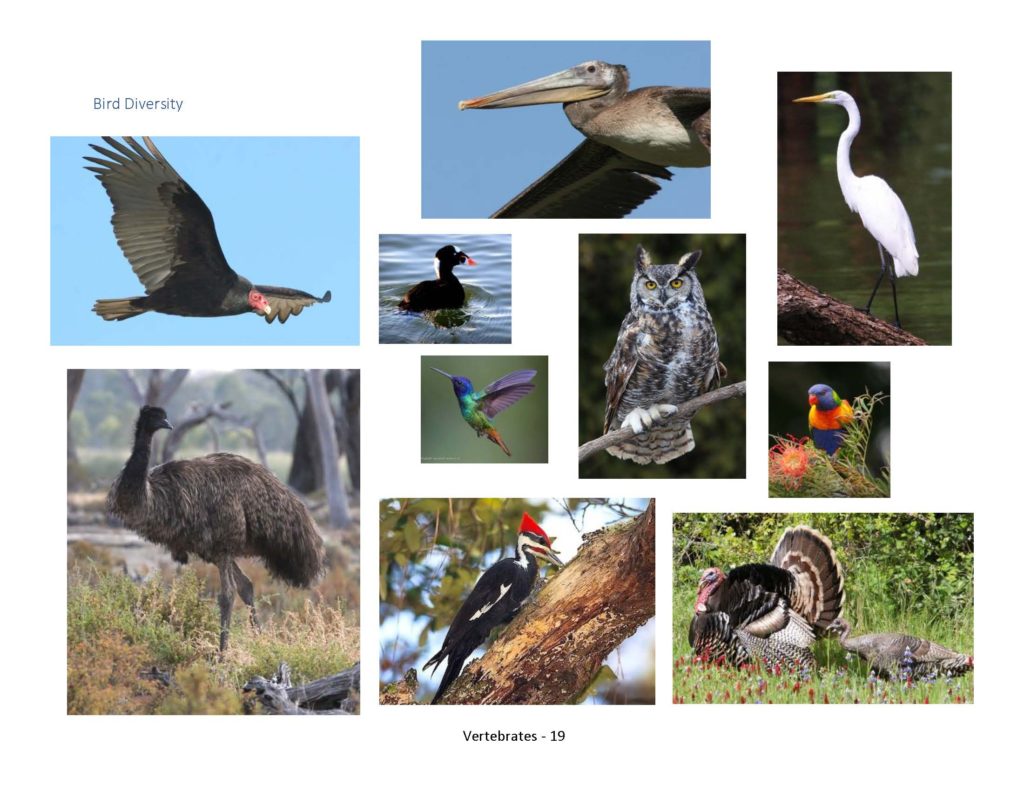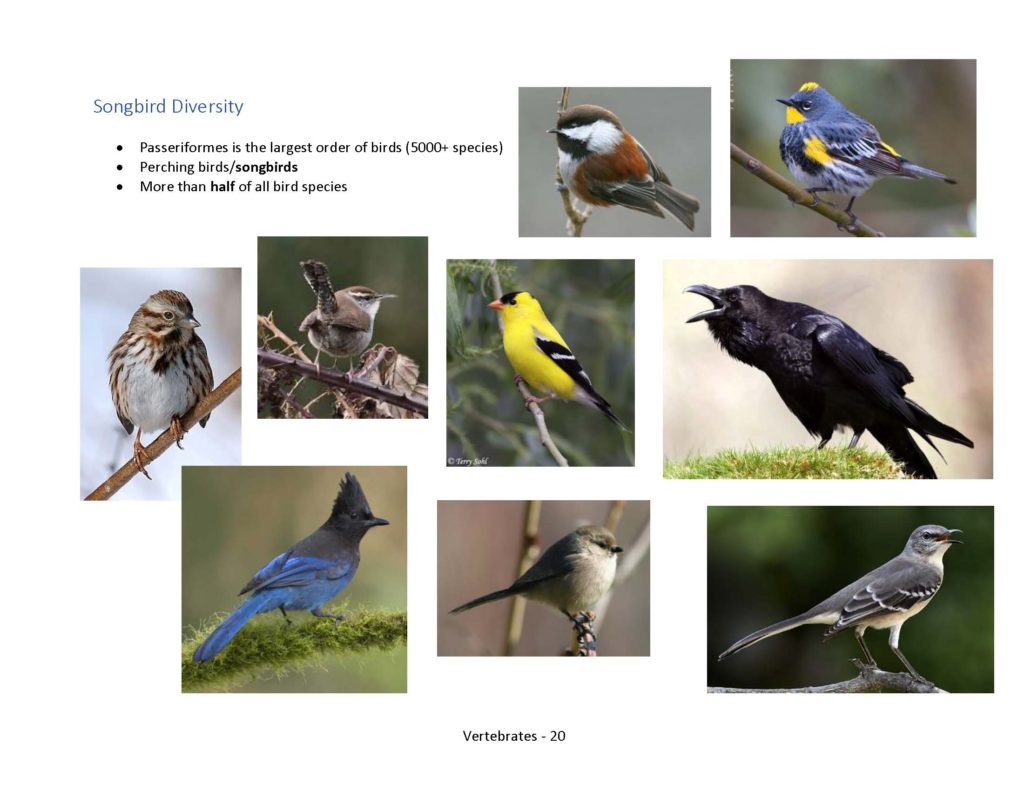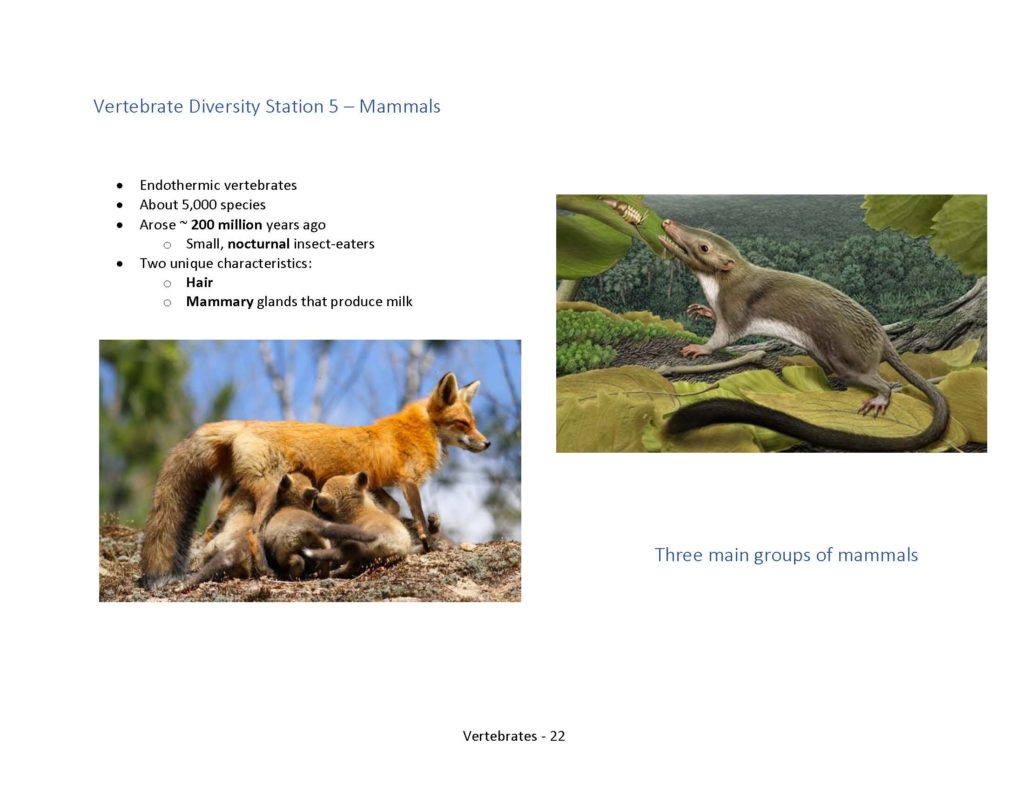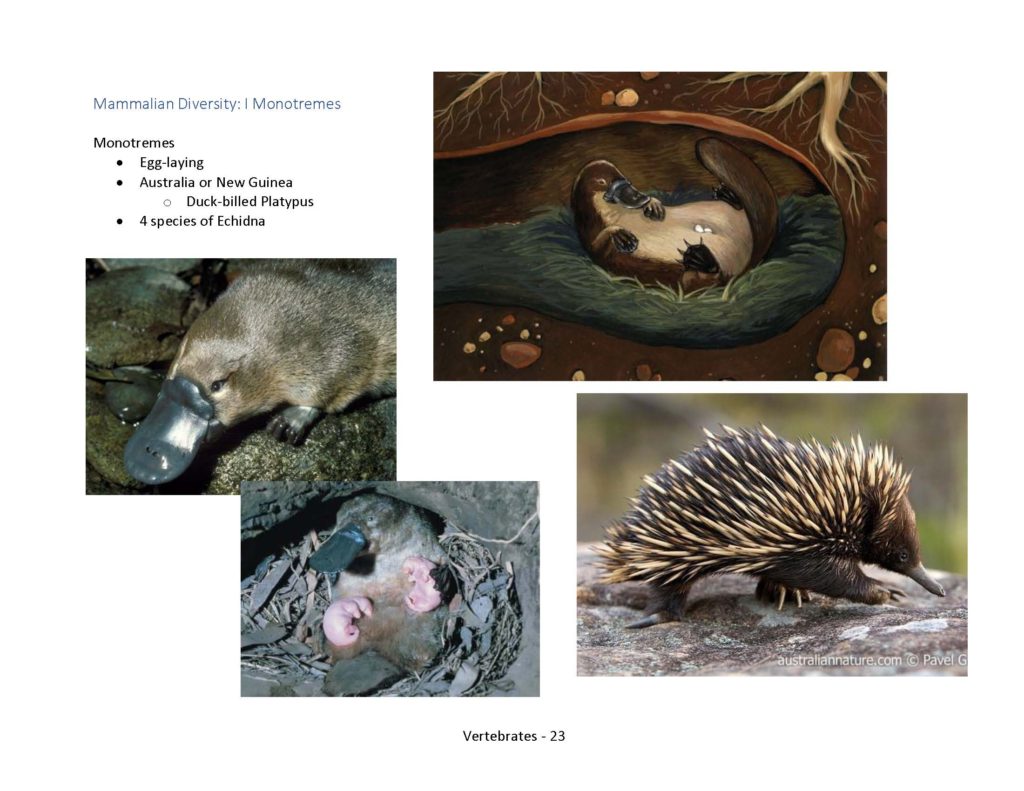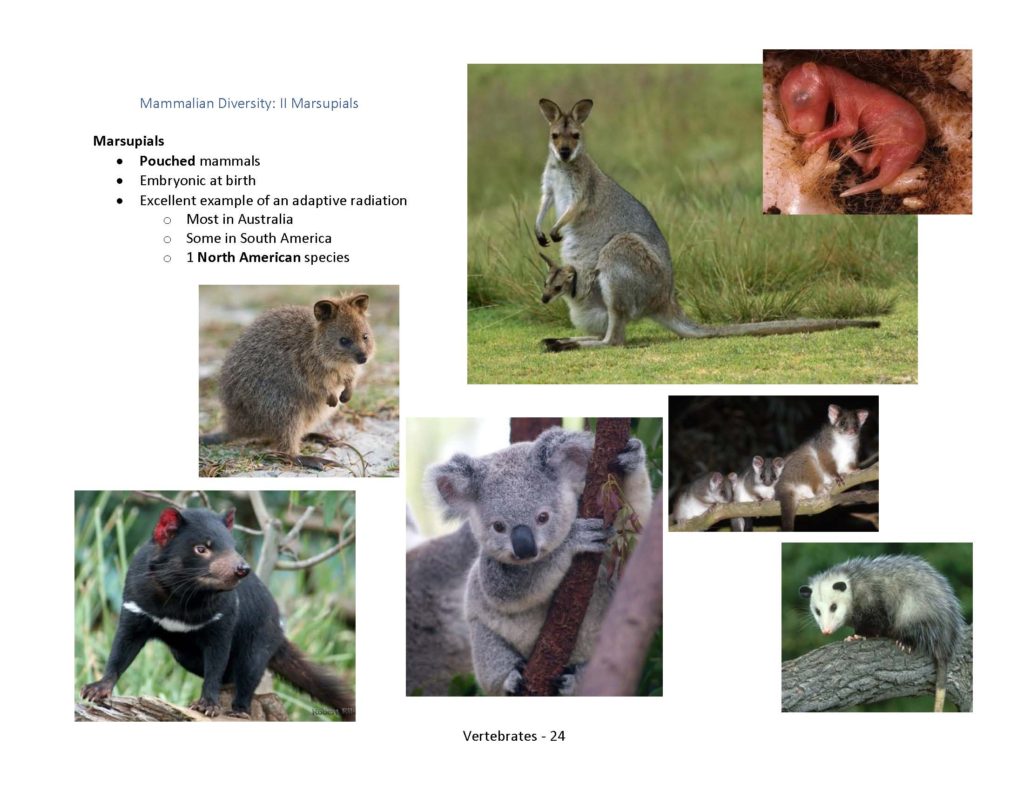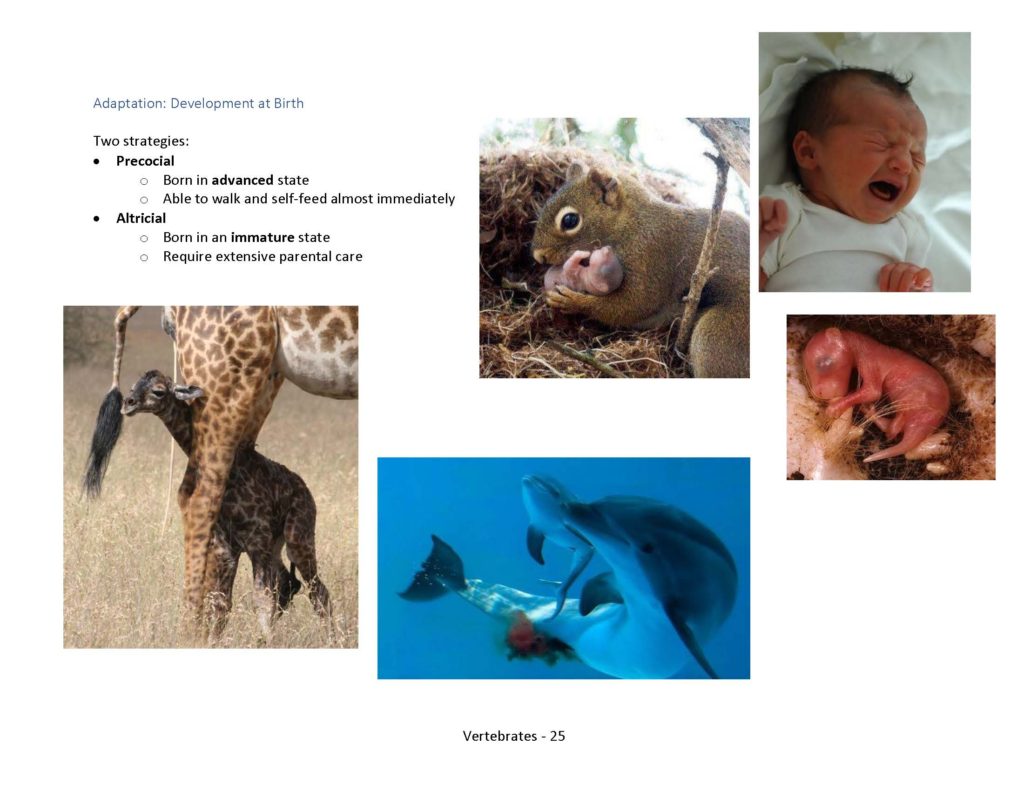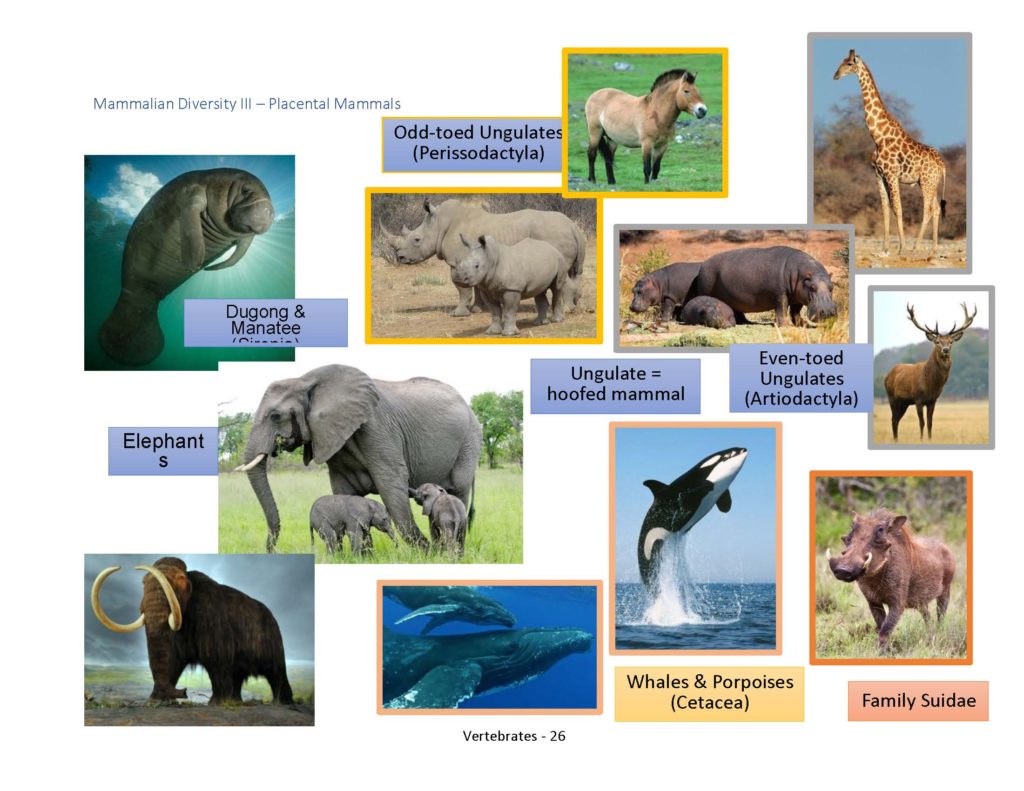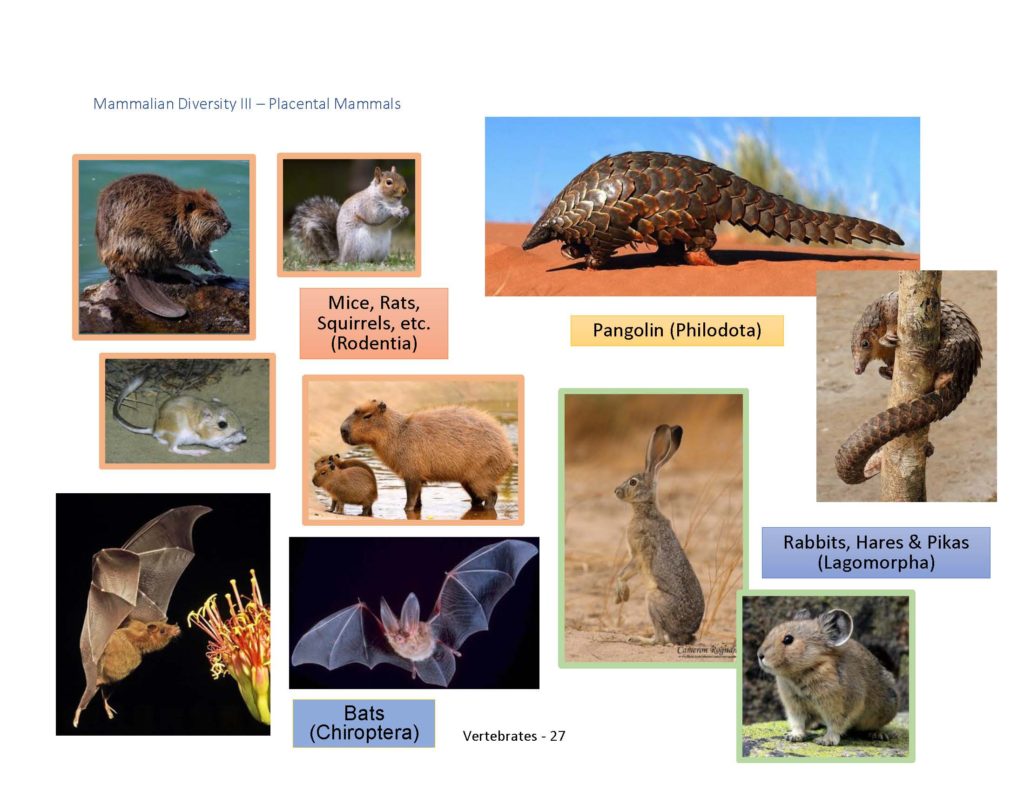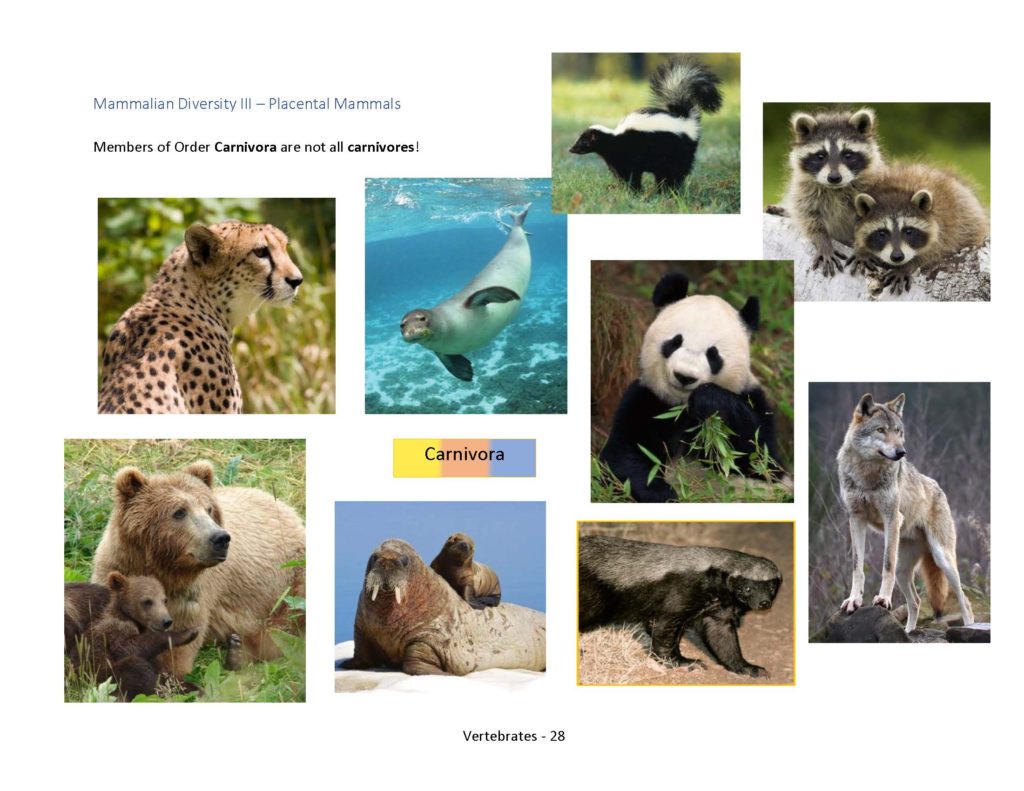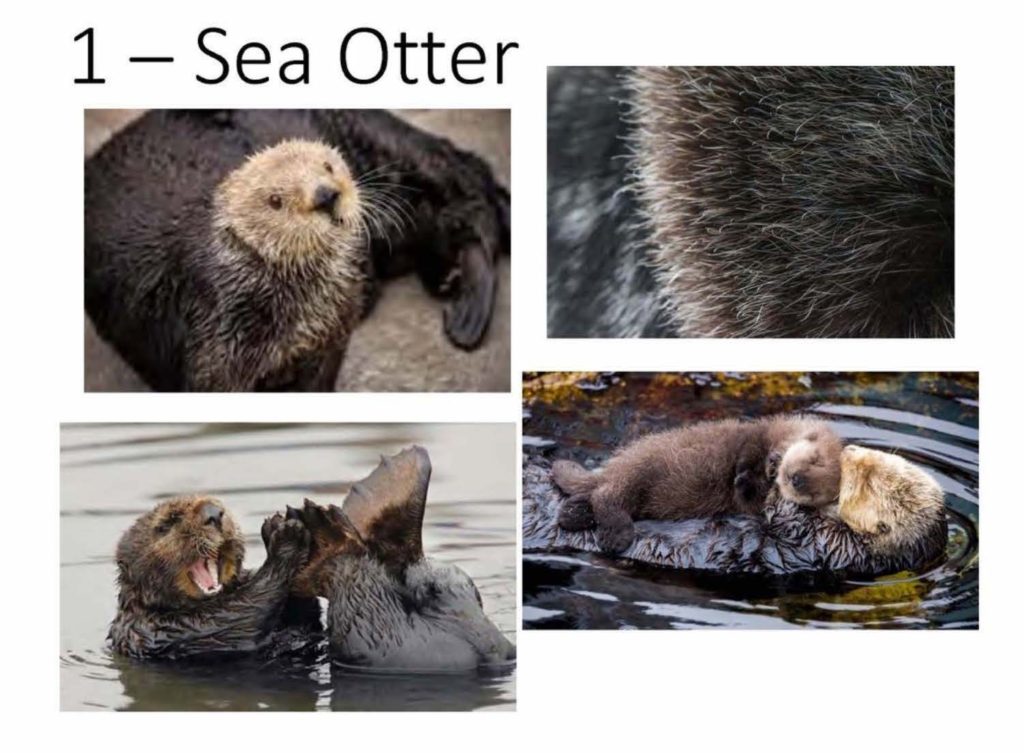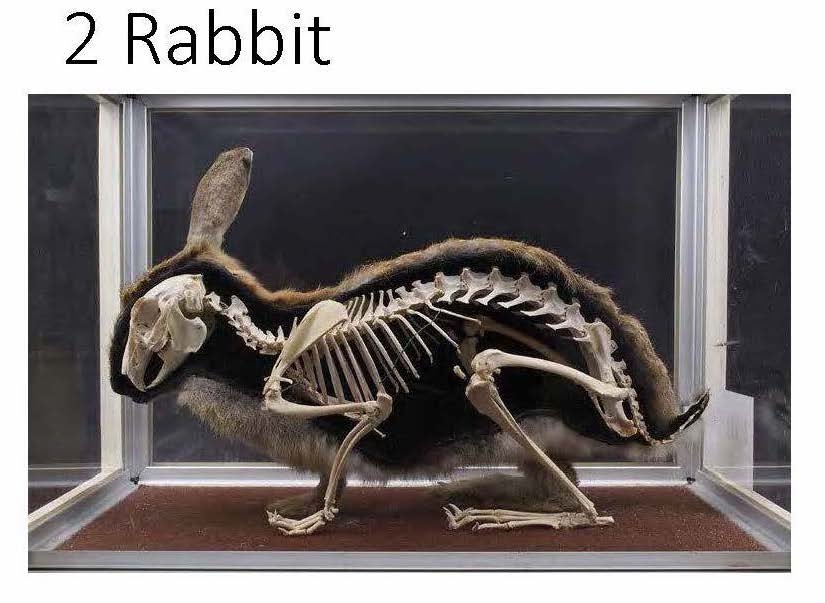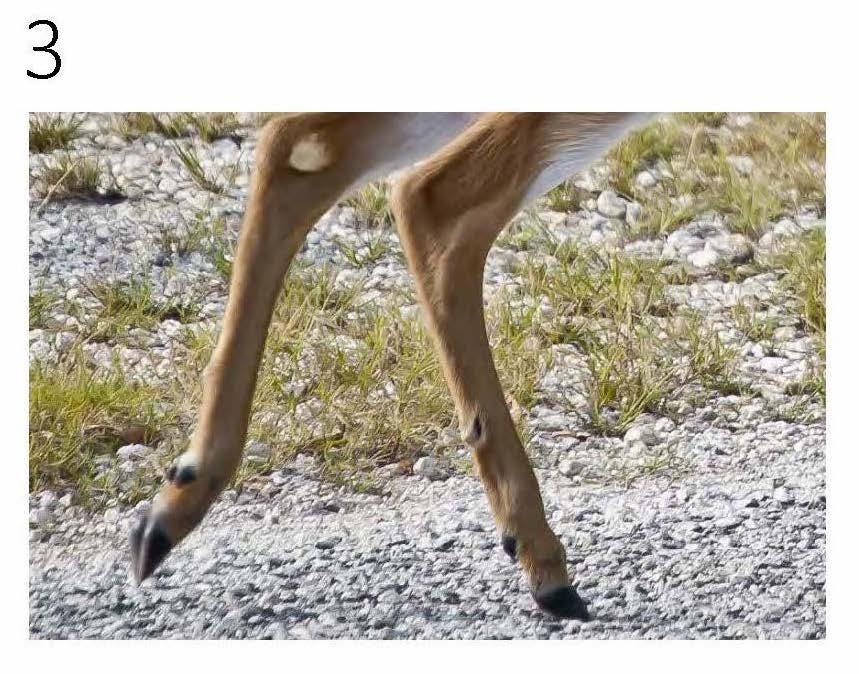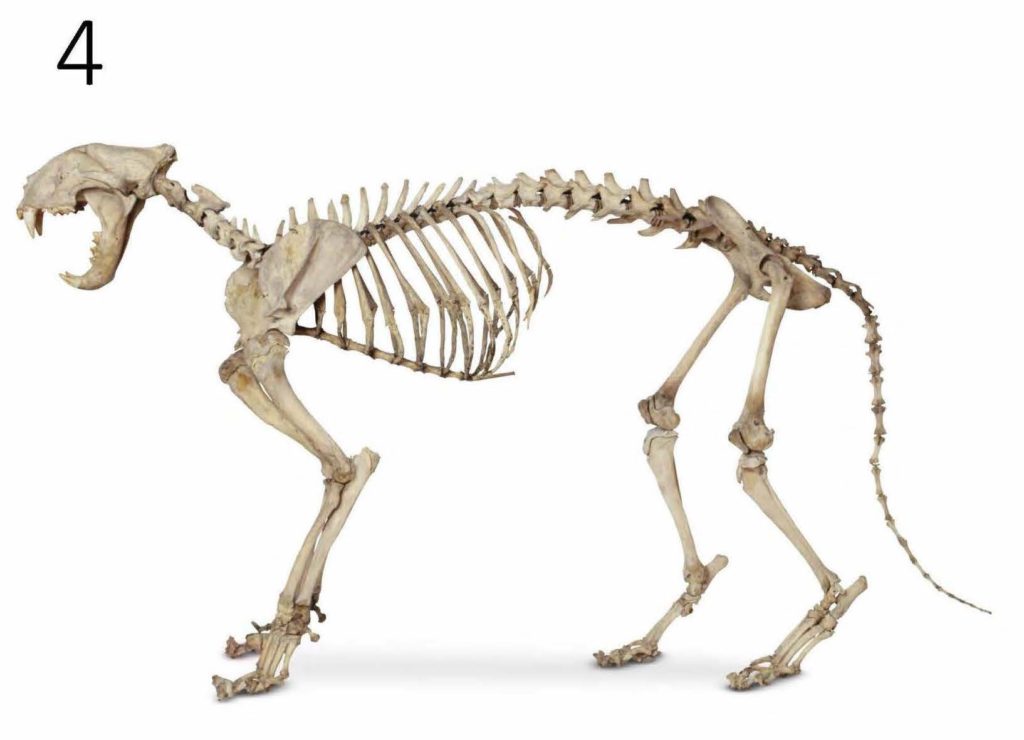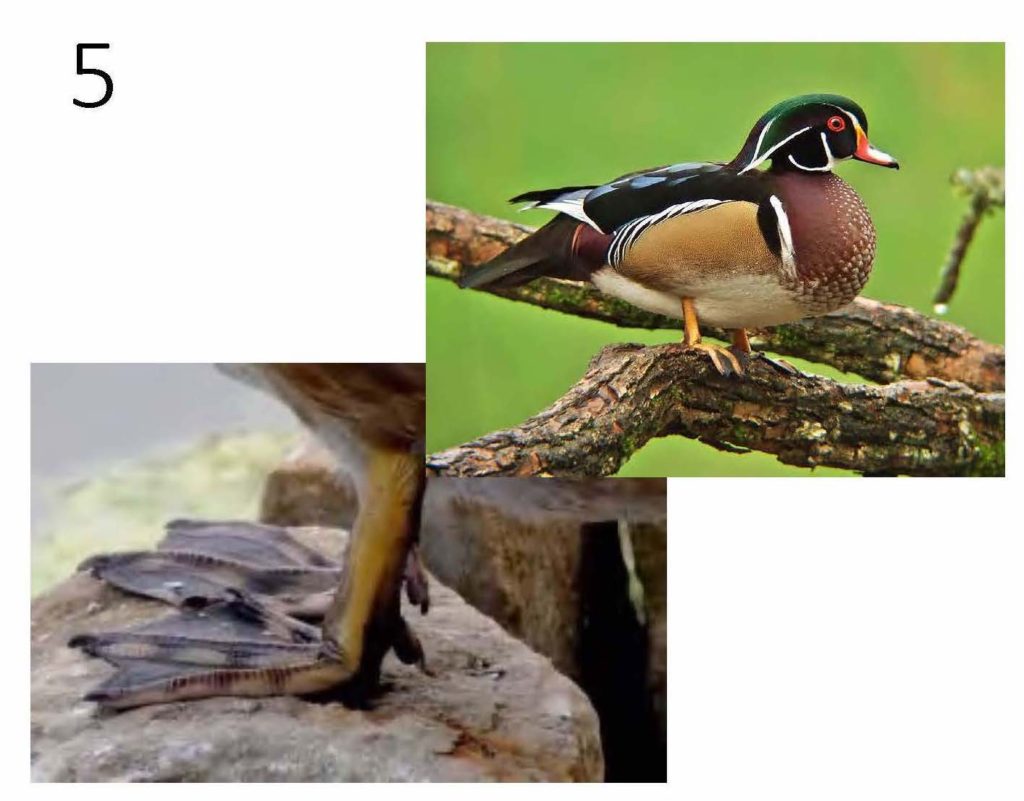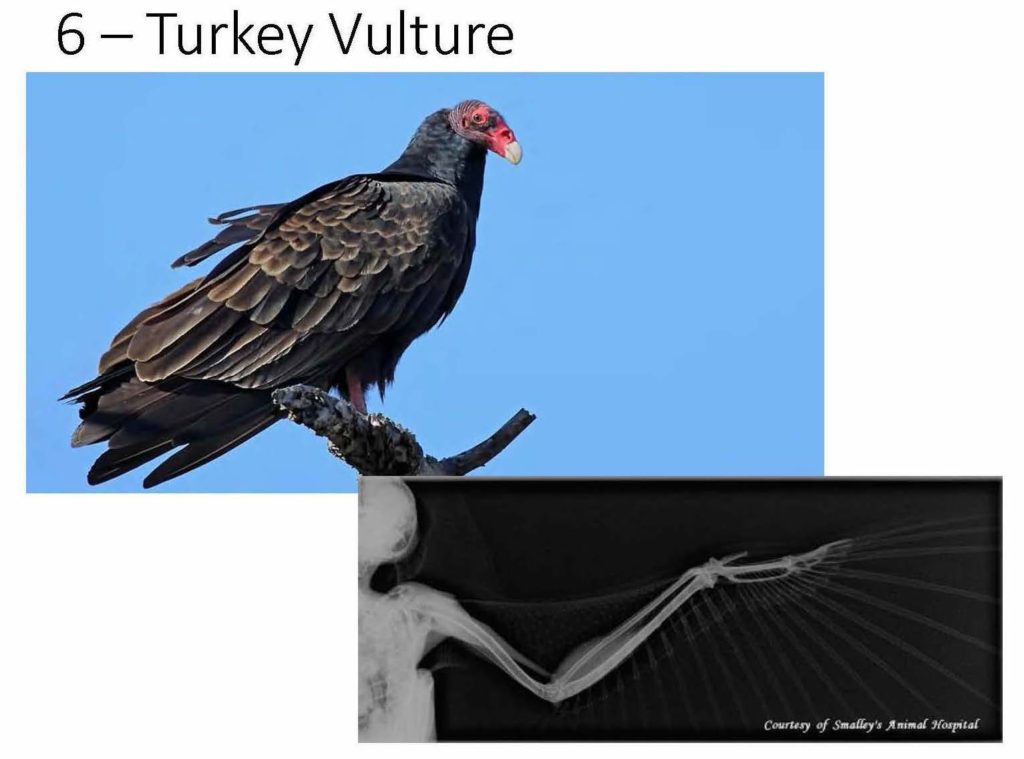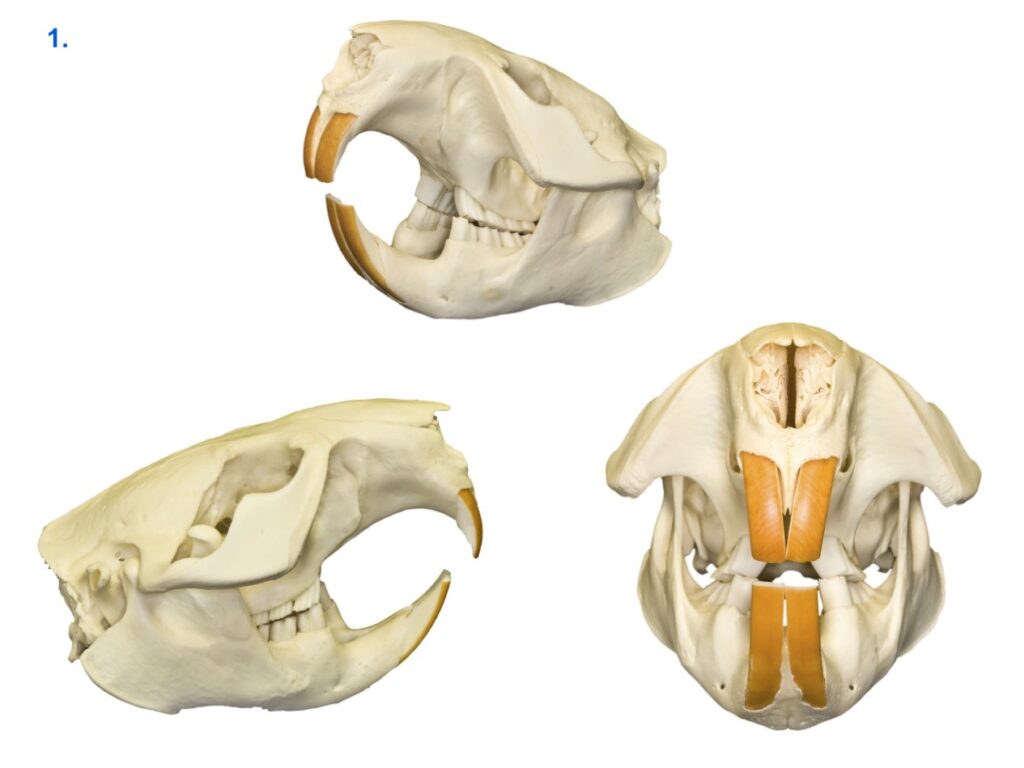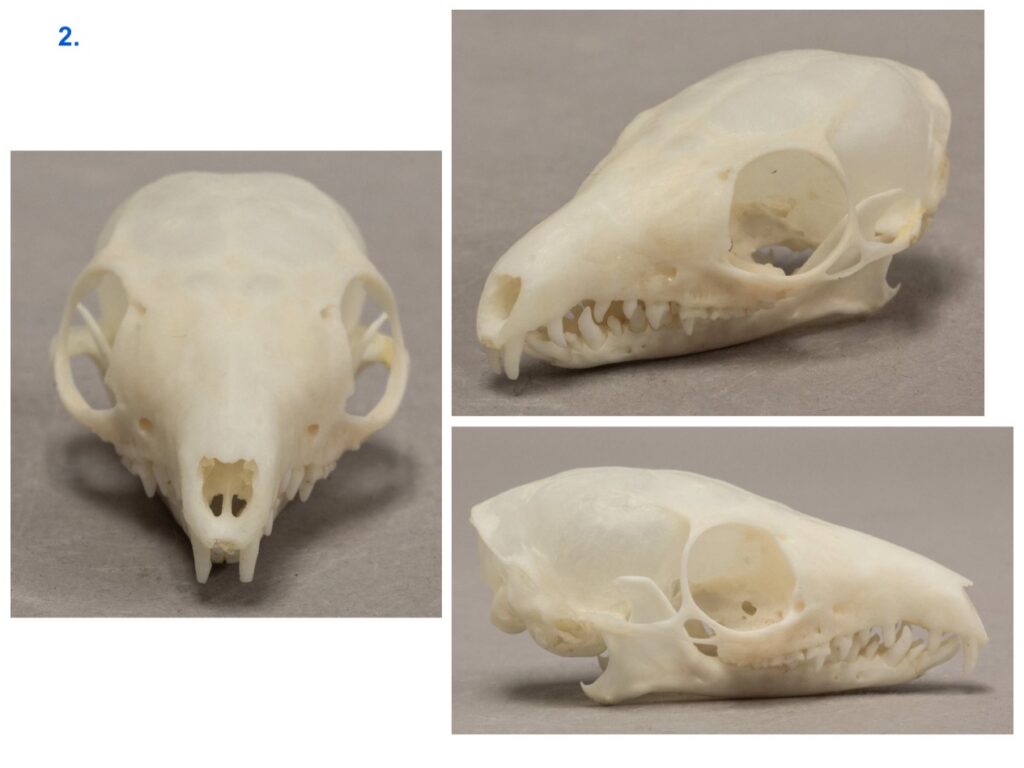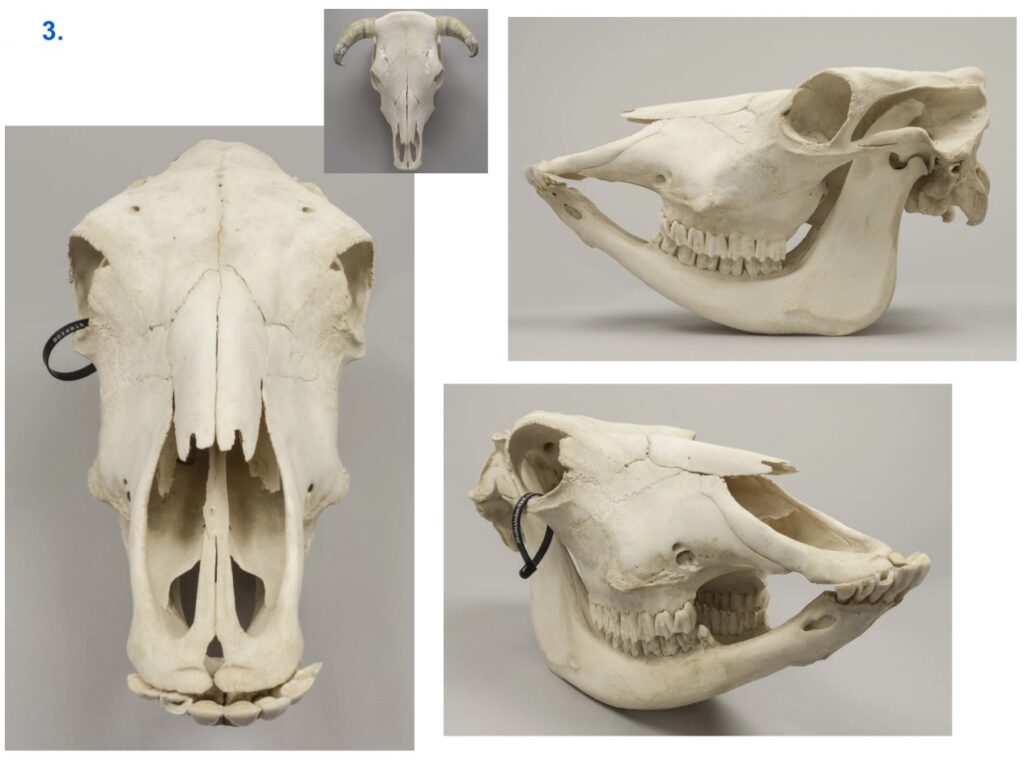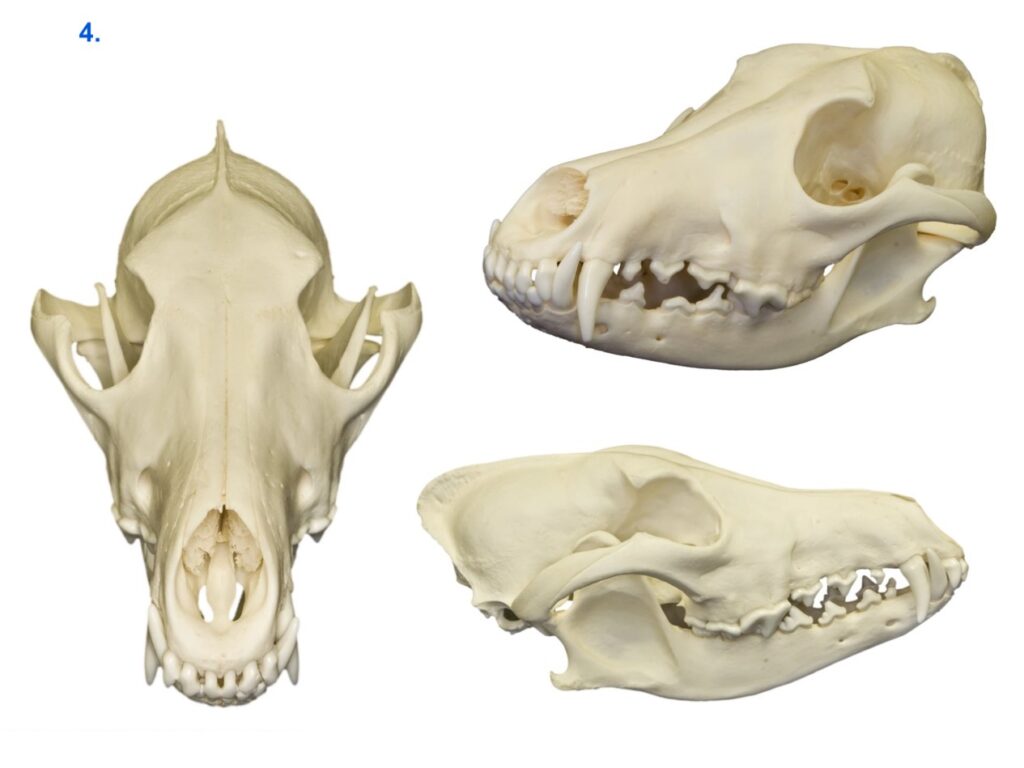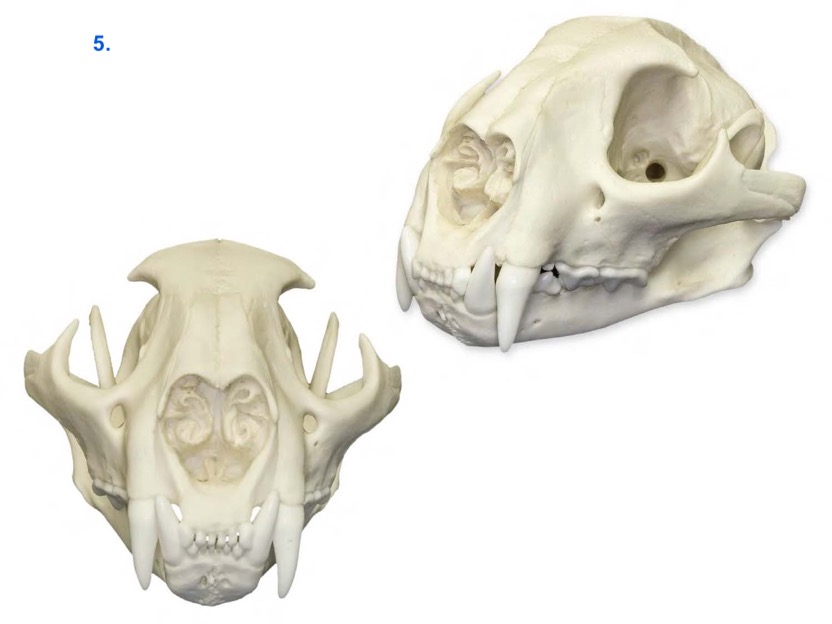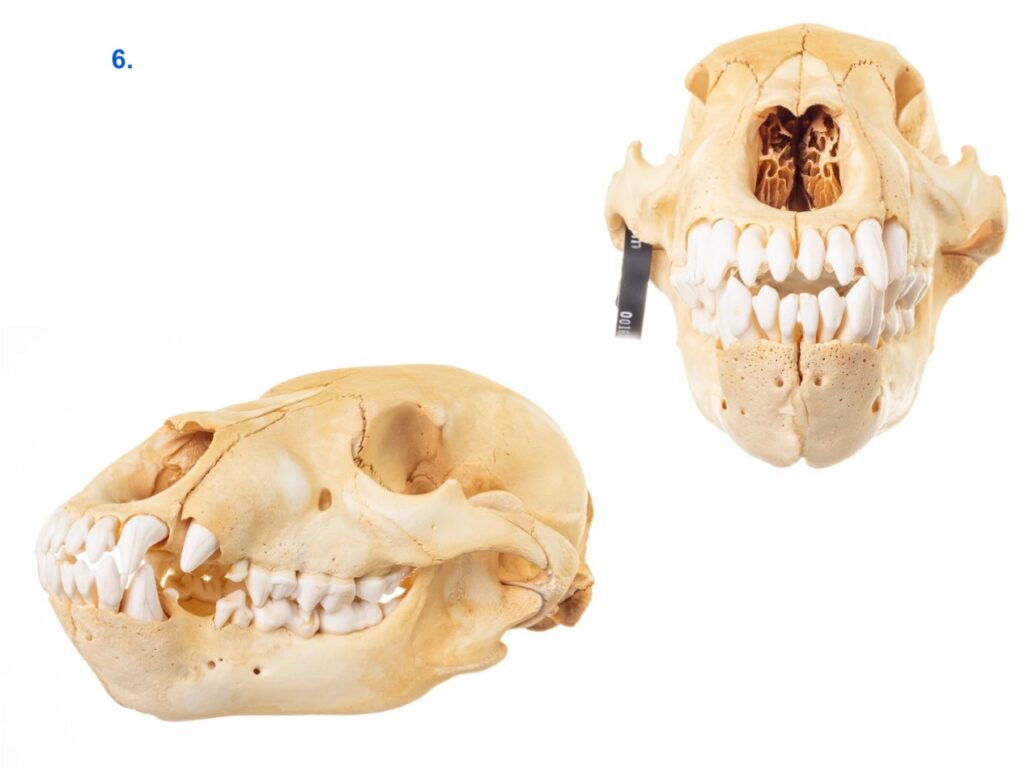Station 1: Fishes

- Describe at least two adaptations fishes possess that allow them to live successfully in aquatic habitats
- Examine the fishes pictured above.
- How do the skeletons of these two animals differ?
- What type of body symmetry do they exhibit?
- What new adaptations do the lobe-finned fishes have, that ray-finned fishes do not?
- Why do you think many people refer to the Coelacanth as a “living fossil?”
Vertebrate Station 2: Amphibians
- Which group of vertebrates was the first to colonize terrestrial habitats?
- List three traits, inherited from lobe-finned fishes, that helped amphibians adapt to life on land.
- Look at the series of transitional fossils pictured on the second “Transition to Land” slide.
- Describe the skeletal changes that took place as fins evolved into legs.
- What are the two major groups of amphibians?
- Explain how their reproductive strategy dictates the habitats in which they are able to live.
Vertebrate Station 3: Reptilian Vertebrates
- Describe two adaptations that these animals possess that allow reptiles to live away from water
- List two characteristics that allow you to tell the difference between venomous rattlesnakes and non-venomous gopher snakes
- List two characteristics that allow you to tell the difference between an alligator and a crocodile.
Vertebrate Station 4: Birds
- Birds are the first group of endothermic animals that we have encountered today.
- Describe the differences between ectotherms and endotherms.
- Why is endothermy advantageous?
- List three adaptations that allow birds to fly
- Which group of birds is the most diverse/has the greatest number of species?
Vertebrate Station 5: Mammals
- What are the two adaptations that are unique to mammals?
- Look at the photos of the pangolin.
- Does this animal appear to belong with the others in this category? Why or why not?
- What structures on your own body are similar, in terms of the material from which they are composed, to the pangolin’s scales?
- List the three groups of mammals
- Give an example of each group
Vertebrate Station 6: Adaptations
Specimen 1
- To which class of vertebrates does this organism belong?
- What type of habitat do you think this animal prefers?
- List two adaptations that could give a clue about its lifestyle.
Specimen 2
- Notice the leg bones on this skeleton. What type of locomotion is suggested by their length and shape?
Specimen 3
- To what animal do you think this leg belongs? What sort of locomotion do you think it uses?
Specimen 4
- This skeleton belongs to a house cat. Knowing what you do about the habits of domestic cats, describe two morphological characteristics that could assist this animal in its lifestyle.
Specimen 5
- What sort of locomotion does this animal use? Explain what physical characteristic helped you determine the form(s) of locomotion.
Specimen 6
- What sort of locomotion does this animal use?
- How do the bones in its “arms” correspond to the bones in your own body?
Vertebrate State 7: Mystery Skulls

Animal skulls can tell us many things about creatures and how they once survived in their natural environment. A few relatively simple observations of an animal’s skull can tell us what the animal ate, whether the animal was predator or prey, and which senses were most important to the animal’s survival. Some of the characteristics of skulls that we use to tell us about how the animals lived are explained below. Teeth: The teeth in an animal skull can tell us whether the animal was a carnivore (meat eater), herbivore (plant eater) or an omnivore (meat and plant eater).
Carnivores have comparatively small, less developed incisors. Incisors play a minor role for carnivores such as grooming. The canine teeth are large, long and pointed for piercing and holding prey. Cheek teeth (pre-molars and molars) are sharp and pointed for cutting and tearing flesh. Some of the upper cheek teeth overlap lower teeth, providing a scissor-like shearing action to cut meat. These teeth are referred to as carnassial teeth. With overlapping cheek teeth and long canines, carnivores do not have the ability to move the lower jaw from side to side in a chewing motion. Carnivores are predators (they kill and eat other animals) and tend to bite, tear and gulp food without any chewing action. The meat eater’s teeth tend to be clean and white because they are not stained by plant material.

Herbivores have large, well developed incisors for cutting plant material. Their canines resemble incisors in form and function. Most ruminant (cud chewing) herbivores (deer, sheep, cattle, etc.) do not have upper incisors or canines. Instead, they have a hard upper palate that serves as a “cutting board” for the lower incisors to cut through plant stems. This arrangement permits the rapid ingestion of large amounts of plant material. Herbivore cheek teeth are large and wide with high, sharp crowns for grinding and chewing plant material. Instead of overlapping, the cheek teeth make surface contact to provide a grinding action. Herbivore teeth are often stained from substances in plants.

Omnivores have a combination of carnivore and herbivore teeth characteristics. Omnivores have fairly large and well developed incisors for cutting plant material. The canine teeth are long and pointed for killing and holding prey. Cheek teeth are a combination of sharp, scissor-like carnassial teeth for shearing meat, and teeth with more rounded cusps for grinding and crushing plant material. There is surface contact between some upper and lower molars. The cheek teeth of these animals can usually tell us their predominant feeding strategy – whether they primarily eat meat or plants. For example, the coyote is an omnivore that is predominately a meat eater and has cheek teeth very similar to a carnivore. However, the coyotes’ most posterior molars have rounded cusps for grinding and crushing plant material. On the other hand, the black bear is an omnivore that is predominately a plant eater and has cheek teeth more closely resembling those of an herbivore.
Eyes: The size of the orbits (eye sockets) in relation to the overall size of the skull, is generally proportional to the sharpness of the animal’s eyesight. The larger the orbits, the better the eyesight of the animal. As an example, mountain lions (and most cats) have very large orbits and hence, very acute vision. The large eyes of cats, and many other nocturnal animals, play a role in their keen night vision.

Nasal Passage: The relative size of the nasal passage on a skull is an indication of the animal’s sense of smell. The thin bony structures inside the nasal passage (nasal turbinates; the Mountain Lion skull contains a good example) provide the framework for membranes which sense odor. The greater the size of these structures, the greater the sense of smell. The short nasal passages of cat skulls tell us that cats do not have a very good sense of smell compared to many other animals and rely more on other senses to locate prey. Conversely, the long nasal passage of a coyote indicates that coyotes have a very keen sense of smell and that this sense is important to the coyote’s survival.
Predator and Prey: Predators are animals that eat other animals and prey are animals that are eaten by other animals. Predators can also become prey. When a cat eats a mouse, the cat is a predator. When a cat is eaten by a coyote, the cat is prey. Predators are always carnivores or omnivores, whereas prey may be carnivores, herbivores or omnivores. When examining skulls to determine predators, we of course look for the teeth characteristics of a carnivore or an omnivore. If the teeth characteristics of a skull are strictly those of an herbivore, we consider the animal to be a prey species. Another skull characteristic that is very useful in determining predator/prey classification is the location of the orbits (eye sockets.) Most predators have the eyes located in a forward position on the skull, which provides the animal with a greater degree of binocular vision: both eyes focus on an object, providing the animal with a greater ability to judge distance (depth perception). Binocular vision is an advantage when attacking prey and an important element of the predator’s survival. Herbivores are strictly prey and most have orbits located on the side of the skull. This placement limits binocular vision, but enhances the animal’s field of view or peripheral vision. These herbivores have monocular vision which means that they can see an object with only one eye. With monocular vision, each eye has a field of view of almost 180 degrees. Therefore, by using both eyes, these animals almost have a 360 degree field of view. This field of vision provides the animal with a greater ability to locate predators and is an important element of their survival. In some herbivores there is some overlap in the field of view and these animals may have partial binocular vision.
Below, several skulls are pictured, including a bear, a coyote, a mountain lion, a cow, a beaver, and a vampire bat. Use the specimens pictured below to complete the chart in your worksheet.
Navigation
Landing page: https://wendystjohn.summerlark.net/2021/04/27/animal-diversity/
Invertebrate Diversity: https://wendystjohn.summerlark.net/2020/11/08/animal-diversity-invertebrates/
Vertebrate Diversity: https://wendystjohn.summerlark.net/2020/11/09/vertebrate-diversity/
